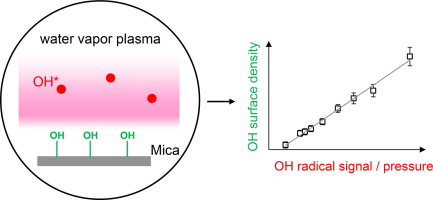当前位置:
X-MOL 学术
›
Appl. Surf. Sci.
›
论文详情
Our official English website, www.x-mol.net, welcomes your
feedback! (Note: you will need to create a separate account there.)
Optimization of mica surface hydroxylation in water vapor plasma monitored by optical emission spectroscopy
Applied Surface Science ( IF 6.3 ) Pub Date : 2020-04-01 , DOI: 10.1016/j.apsusc.2020.145362 Patrick Rupper , Martin Amberg , Dirk Hegemann , Manfred Heuberger
Applied Surface Science ( IF 6.3 ) Pub Date : 2020-04-01 , DOI: 10.1016/j.apsusc.2020.145362 Patrick Rupper , Martin Amberg , Dirk Hegemann , Manfred Heuberger

|
Abstract Mica, a mineral consisting of alumino-silicate layers, can be cleaved to obtain atomically smooth surfaces, and it is often used as a model substrate for surface force measurements. Due to mica's chemical inertness, covalent surface modifications are not straightforward. By applying a water vapor plasma treatment, reactive silanol groups can be generated on the surface. Up to now, the optimization of the plasma process was a time-consuming trial-and-error process. Furthermore, no clear correlation between the plasma parameters and the hydroxyl surface density was elucidated. To overcome such limitations, we invoke in-situ optical emission spectroscopy (OES). A correlation between the pressure-normalized OES hydroxyl intensity and the surface density of hydroxyl groups was found, which allows real-time optimization of the plasma conditions. The density of silanol groups was quantified via chemical derivatization X-ray photoelectron spectroscopy (XPS) using a fluorinated monochlorosilane. An apparent upper limit for the hydroxyl surface density of 2.7 Si OH/nm2 was found—the limitation being imposed by packing restraints of the derivatizing reagent. While real surface density may be underestimated by derivatization, the obtained maximum value is an order of magnitude higher than obtained from wet-chemical hydroxylation, and, it is above the hitherto highest reported values for water vapor plasma treatment.
中文翻译:

光发射光谱监测水蒸气等离子体中云母表面羟基化的优化
摘要 云母是一种由铝硅酸盐层组成的矿物,可通过劈裂获得原子级光滑的表面,通常用作表面力测量的模型基底。由于云母的化学惰性,共价表面改性并不简单。通过应用水蒸气等离子体处理,可以在表面生成反应性硅烷醇基团。迄今为止,等离子体工艺的优化是一个耗时的试错过程。此外,没有阐明等离子体参数和羟基表面密度之间的明确相关性。为了克服这些限制,我们调用了原位光发射光谱 (OES)。发现压力归一化的 OES 羟基强度与羟基的表面密度之间存在相关性,这允许实时优化等离子体条件。硅烷醇基团的密度通过使用氟化单氯硅烷的化学衍生化 X 射线光电子能谱 (XPS) 进行量化。发现羟基表面密度的明显上限为 2.7 Si OH/nm2——该限制是由衍生试剂的堆积限制所强加的。虽然衍生化可能会低估实际表面密度,但获得的最大值比湿化学羟基化获得的最大值高一个数量级,并且高于迄今为止报道的水蒸气等离子体处理的最高值。7 Si OH/nm2 被发现——这是由衍生试剂的堆积限制所施加的限制。虽然衍生化可能会低估实际表面密度,但获得的最大值比湿化学羟基化获得的最大值高一个数量级,并且高于迄今为止报道的水蒸气等离子体处理的最高值。7 Si OH/nm2 被发现——这是由衍生试剂的堆积限制所施加的限制。虽然衍生化可能会低估实际表面密度,但获得的最大值比湿化学羟基化获得的最大值高一个数量级,并且高于迄今为止报道的水蒸气等离子体处理的最高值。
更新日期:2020-04-01
中文翻译:

光发射光谱监测水蒸气等离子体中云母表面羟基化的优化
摘要 云母是一种由铝硅酸盐层组成的矿物,可通过劈裂获得原子级光滑的表面,通常用作表面力测量的模型基底。由于云母的化学惰性,共价表面改性并不简单。通过应用水蒸气等离子体处理,可以在表面生成反应性硅烷醇基团。迄今为止,等离子体工艺的优化是一个耗时的试错过程。此外,没有阐明等离子体参数和羟基表面密度之间的明确相关性。为了克服这些限制,我们调用了原位光发射光谱 (OES)。发现压力归一化的 OES 羟基强度与羟基的表面密度之间存在相关性,这允许实时优化等离子体条件。硅烷醇基团的密度通过使用氟化单氯硅烷的化学衍生化 X 射线光电子能谱 (XPS) 进行量化。发现羟基表面密度的明显上限为 2.7 Si OH/nm2——该限制是由衍生试剂的堆积限制所强加的。虽然衍生化可能会低估实际表面密度,但获得的最大值比湿化学羟基化获得的最大值高一个数量级,并且高于迄今为止报道的水蒸气等离子体处理的最高值。7 Si OH/nm2 被发现——这是由衍生试剂的堆积限制所施加的限制。虽然衍生化可能会低估实际表面密度,但获得的最大值比湿化学羟基化获得的最大值高一个数量级,并且高于迄今为止报道的水蒸气等离子体处理的最高值。7 Si OH/nm2 被发现——这是由衍生试剂的堆积限制所施加的限制。虽然衍生化可能会低估实际表面密度,但获得的最大值比湿化学羟基化获得的最大值高一个数量级,并且高于迄今为止报道的水蒸气等离子体处理的最高值。










































 京公网安备 11010802027423号
京公网安备 11010802027423号